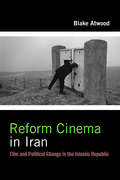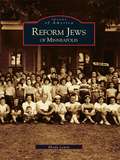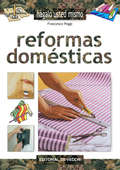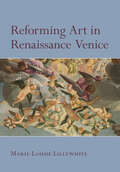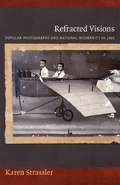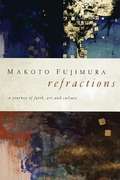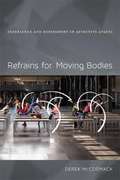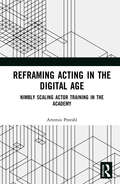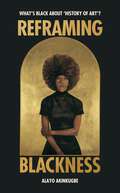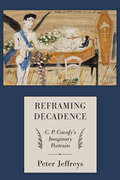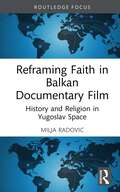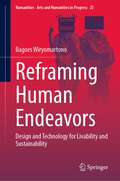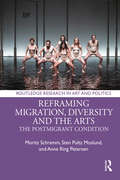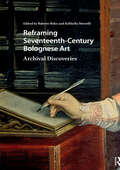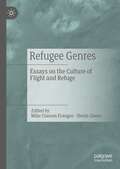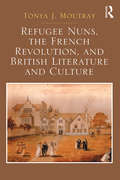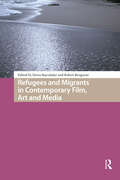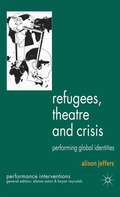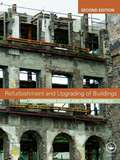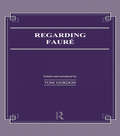- Table View
- List View
Reform Cinema in Iran: Film and Political Change in the Islamic Republic (Film and Culture Series)
by Blake AtwoodIt is nearly impossible to separate contemporary Iranian cinema from the Islamic revolution that transformed film production in the country in the late 1970s. As the aims of the revolution shifted and hardened once Khomeini took power and as an eight-year war with Iraq dragged on, Iranian filmmakers confronted new restrictions. In the 1990s, however, the Reformist Movement, led by Mohammad Khatami, and the film industry, developed an unlikely partnership that moved audiences away from revolutionary ideas and toward a discourse of reform. In Reform Cinema in Iran, Blake Atwood examines how new industrial and aesthetic practices created a distinct cultural and political style in Iranian film between 1989 and 2007. Atwood analyzes a range of popular, art, and documentary films. He provides new readings of internationally recognized films such as Abbas Kiarostami's Taste of Cherry (1997) and Mohsen Makhmalbaf's Time for Love (1990), as well as those by Rakhshan Bani, Masud Kiami, and other key Iranian directors. At the same time, he also considers how filmmakers and the film industry were affected by larger political and religious trends that took shape during Mohammad Khatami's presidency (1997-2005). Atwood analyzes political speeches, religious sermons, and newspaper editorials and pays close attention to technological developments, particularly the rise of video, to determine their role in democratizing filmmaking and realizing the goals of political reform. He concludes with a look at the legacy of reform cinema, including films produced under Mahmoud Ahmadinejad, whose neoconservative discourse rejected the policies of reform that preceded him.
Reform Jews of Minneapolis (Images of America)
by Rhoda LewinThe German Jews who began coming to Minneapolis in the 1850s quickly entered society as doctors, lawyers, professors, merchants, and leaders in clothing and cigar manufacturing. In 1878 they founded Shaarai Tov, now Temple Israel--one of the ten largest Reform congregations in the U.S. today. They also enjoyed a busy social and cultural life, and both husbands and wives involved themselves in social service and welfare organizations. Including historic and present-day photographs and tales of the community--schools, synagogues, organizations, and outdoor activities--this collection uncovers the challenges and triumphs of Reform Jews in Minneapolis.
Reformas domésticas
by Francesco Poggi* Renovar uno mismo su propia casa no es una tarea imposible, si se siguen con atención las indicaciones de este libro. * Pintar las paredes, empapelar, efectuar revestimientos con madera, tapizar con moqueta, colocar el parqué, embaldosar y mil tareas más no tendrán secretos con las detalladas explicaciones y las ilustraciones didácticas que llenan las páginas de esta obra. * Así, podrá decir por fin adiós a las facturas astronómicas de los pintores y tapiceros, y tendrá la satisfacción de un trabajo realizado con esmero.
Reformations Of The Body
by Jennifer WaldronThis project takes the human body and the bodily senses as joints that articulate new kinds of connections between church and theatre and overturns a longstanding notion about theatrical phenomenology in this period.
Reforming Art in Renaissance Venice
by Marie-Louise LillywhiteThe spiritual turmoil of the sixteenth century had a profound impact on religious life throughout Italy. Art and architecture were directly implicated in the seismic historical events of the age, as the Catholic Church countered Protestant iconoclasm through the embrace of sacred images as decreed by the Council of Trent in 1563. In this volume, Marie-Louise Lillywhite considers the impact of religious reform on the devotional art and architecture of sixteenth-century Venice. Interrogating early modern censorship, artistic liberty, notions of decorum tied to depictions of the body, and the role of sacred images in the shaping of local identity, she shows how Venice, a crossroads city exposed to a rich gamut of religious and artistic currents, serves as a fascinating case study through which to explore these themes. Her study reconstructs the conditions that enabled artistic invention to prevail and how artists became interpreters of spiritual values.
Refracted Visions: Popular Photography and National Modernity in Java
by Karen StrasslerA young couple poses before a painted backdrop depicting a modern building set in a volcanic landscape; a college student grabs his camera as he heads to a political demonstration; a man poses stiffly for his identity photograph; amateur photographers look for picturesque images in a rural village; an old woman leafs through a family album. In Refracted Visions, Karen Strassler argues that popular photographic practices such as these have played a crucial role in the making of modern national subjects in postcolonial Java. Contending that photographic genres cultivate distinctive ways of seeing and positioning oneself and others within the affective, ideological, and temporal location of Indonesia, she examines genres ranging from state identification photos to pictures documenting family rituals. Oriented to projects of selfhood, memory, and social affiliation, popular photographs recast national iconographies in an intimate register. They convey the longings of Indonesian national modernity: nostalgia for rural idylls and "tradition," desires for the trappings of modernity and affluence, dreams of historical agency, and hopes for political authenticity. Yet photography also brings people into contact with ideas and images that transcend and at times undermine a strictly national frame. Photography's primary practitioners in the postcolonial era have been Chinese Indonesians. Acting as cultural brokers who translate global and colonial imageries into national idioms, these members of a transnational minority have helped shape the visual contours of Indonesian belonging even as their own place within the nation remains tenuous. Refracted Visions illuminates the ways that everyday photographic practices generate visual habits that in turn give rise to political subjects and communities.
Refractions: A Journey Of Faith, Art, And Culture
by Makoto FujimuraA collection of essays, thoughts, and prayers from award-winning artist Makoto Fujimura, Refractions brings people of all backgrounds together in conversation and meditation on culture, art, and humanity.
Refrains for Moving Bodies: Experience and Experiment in Affective Spaces
by Derek P. MccormackIn Refrains for Moving Bodies, Derek P. McCormack explores the kinds of experiments with experience that can take place in the affective spaces generated when bodies move. Drawing out new connections between thinkers including Henri Lefebvre, William James, John Dewey, Gregory Bateson, Félix Guattari, and Gilles Deleuze, McCormack argues for a critically affirmative experimentalism responsive to the opportunities such spaces provide for rethinking and remaking maps of experience. Foregrounding the rhythmic and atmospheric qualities of these spaces, he demonstrates the particular value of Deleuze and Guattari's concept of the "refrain" for thinking and diagramming affect, bodies, and space-times together in creative ways, putting this concept to work to animate empirical encounters with practices and technologies as varied as dance therapy, choreography, radio sports commentary, and music video. What emerges are geographies of experimental participation that perform and disclose inventive ways of thinking within the myriad spaces where the affective capacities of bodies are modulated through moving.
Reframing Acting in the Digital Age: Nimbly Scaling Actor Training in the Academy
by Artemis PreeshlReframing Acting in the Digital Age: Nimbly Scaling Actor Training in the Academy refocuses how actors work in TV, film, and stage. In this refreshing text, Preeshl integrates original interviews with 25 theatre, film, TV, and digital media experts from leading international programs to create an essential contribution to actor training studies. These interviews cover diverse topics such as contemporary training methods, industry standards, and experiential learning, incorporating interdisciplinary recommendations from academics and professionals alike to navigate undergraduate actor training in the digital age. Digitally native undergraduates arrive at university being well versed in the digital and technological world, but as technologically savvy as these Millenials and Generation Z are, Preeshl and her interviewees show how acting and production degree programs can reframe these competencies to enable students to acquire and transfer digital skills. This phenomenological study bridges actor training methods across media to promote 'scaling' to update undergraduate actor training for the digital age. By applying the recommendations of these experts to curricular practices, universities may increase market share, diversity, and graduate employability. This in-depth field study is a vital read for acting teachers, students, professional actors, and scholars within theatre and film programs.
Reframing Blackness: What’s Black about “History of Art”?
by Alayo Akinkugbe‘Akinkugbe is a brilliant new writer and thinker challenging art history. This book is urgent, essential, accessible and it needs to be on every art history reading list' Bernardine Evaristo‘A sparkling debut. Bold, eloquent, personal and clear-eyed, Alayo Akinkugbe is a major new voice in writing about art, museums and culture. This book will shift your frames of reference, expand your canvas, and give you hope for the future — changing how you look at art while also making you look again at your ways of seeing’ Dan Hicks, author of The Brutish Museums‘Thorough, accessible, essential’ Katy Hessel, author of The Story of Art without Men'To explore a history of Black communities across centuries of art is a love letter to the practice, a gift of knowledge and an ode to those who’s creative expressions give us much to be inspired by today' Sofia Akel, cultural historian and founderSince the inception of mainstream art history, Blackness has been distinctly ignored.In Reframing Blackness, art historian and founder of @ABlackHistoryOfArt, Alayo Akinkugbe challenges this void.Exploring the presentation of Black figures in Western art, as well as Blackness in museums, in feminist art movements and in the curriculum, Alayo unveils an overlooked but integral part of our collective art history.Refreshing and accessible, this promises to start a much-needed conversation in culture and education.
Reframing Decadence: C. P. Cavafy's Imaginary Portraits
by Peter JeffreysDuring his sojourn in England during the 1870s, a young Cavafy found himself enthralled by the aesthetic movement of cosmopolitan London. It was during these years that he encountered the canvases and personalities of Pre-Raphaelite painters, including Burne-Jones and Whistler, as well as works of aesthetic writers who were effecting a revolution in British literary culture and channeling influences from France that would gradually coalesce into an international decadent movement. In Reframing Decadence Peter Jeffreys returns us to this critical period of Cavafy's life, showing the poet's creative indebtedness to British and French avant-garde aesthetes whose collective impact on his poetry proved to be profound. In the process, Jeffreys offers a critical reappraisal of Cavafy’s relation to Victorian aestheticism and French literary decadence. Foremost among the tropes of decadence that captivated Cavafy were the decline of imperial Rome, the rise of Christianity, and the lingering twilight of Byzantium. The influence of Walter Pater on Cavafy’s view of classical and late-antique history was immense, inflected as it was with an unapologetic homoerotic aesthetic that Cavafy would adopt as his own, making Pater’s imaginary portraits an important touchstone for his own historicizing poetry. Cavafy would move beyond Pater to explore a more openly homoerotic sensuality but he never quite abandoned this rich Victorian legacy, one that contributed greatly to his emergence as a global poet. Jeffreys concludes by considering Cavafy’s current popularity as a gay poet and his curious relation to kitsch as manifest in his ongoing popularity via translation and visual media.
Reframing Faith in Balkan Documentary Film: History and Religion in Yugoslav Space (Routledge Focus on Film Studies)
by Milja RadovicReframing Faith in Balkan Documentary Film presents the first systematic study of the cinematic representations of religion in the early documentary film on the Balkan Peninsula from 1896 to 1939. By looking at faith through the concept of frame, this book sheds new light on the historical realities of the period as seen by the filmmakers and facilitates rediscovering the world of lost religious communities on the territory of Yugoslavia. Placing film language at the heart of scientific research and introducing the frame as a method of analysis, this book proposes novel ways of reading history as written on the reel.This intricate and in-depth study will interest film historians, particularly those interested in Balkan and European cinema, as well as historians of the Balkans, religion, and Eastern Europe.
Reframing Human Endeavors: Design and Technology for Livability and Sustainability (Numanities - Arts and Humanities in Progress #25)
by Bagoes WiryomartonoThis ambitious text is a monograph about human experiences concerning the potentialities, capacities, and features of humankind from the wholeness of the collective mind body spirit. The purpose in reframing human endeavors is for enhanced alignment for livability and sustainability. This book departs from the concept and practice of “design and technology” and argues that most crises that endanger and destruct our ecological livability and sustainability come from our way of thinking and doing with “design and technology” based on the necessity for control. It is the control for overcoming the fear of scarcity, starvation, and the unknown. This book is rather an attempt to find alternate way of decision-making thru holistic methods. It appeals to researchers working in design, sustainability, architecture and urban studies.
Reframing Immersive Theatre
by James FriezeThis diverse collection of essays and testimonies challenges critical orthodoxies about the twenty-first century boom in immersive theatre and performance. A culturally and institutionally eclectic range of producers and critics comprehensively reconsider the term 'immersive' and the practices it has been used to describe. Applying ecological, phenomenological and political ideas to both renowned and lesser-known performances, contributing scholars and artists offers fresh ideas on the ethics and practicalities of participatory performance. These ideas interrogate claims that have frequently been made by producers and by critics that participatory performance extends engagement. These claims are interrogated across nine dimensions of engagement: bodily, technological, spatial, temporal, spiritual, performative, pedagogical, textual, social. Enquiry is focussed along the following seams of analysis: the participant as co-designer; the challenges facing the facilitator of immersive/participatory performance; the challenges facing the critic of immersive/participatory performance; how and why immersion troubles boundaries between the material and the magical.
Reframing Migration, Diversity and the Arts: The Postmigrant Condition (Routledge Research in Art and Politics)
by Sten Pultz Moslund Moritz Schramm Anne Ring Petersen Mirjam Gebauer Hans Christian Post Sabrina Vitting-Seerup Frauke WiegandThis book offers a compelling study of contemporary developments in European migration studies and the representation of migration in the arts and cultural institutions. It introduces scholars and students to the new concept of ‘postmigration’, offering a review of the origin of the concept (in Berlin) and how it has taken on a variety of meanings and works in different ways within different national, cultural and disciplinary contexts. The authors explore postmigrant theory in relation to the visual arts, theater, film and literature as well as the representation of migration and cultural diversity in cultural institutions, offering case studies of postmigrant analyses of contemporary works of art from Europe (mainly Denmark, Germany and Great Britain).
Reframing Photography: Theory and Practice
by Bill Anthes Rebekah ModrakTo fully understand photography, it is essential to study both the theoretical and the technical. This book combines theory and practice in one text, exploring photographic ideas alongside processes.
Reframing Screen Performance
by Cynthia Baron Sharon Marie Carnicke"A significant contribution to the literature on screen performance studies, Reframing Screen Performance brings the study of film acting up to date. It should be of interest to those within cinema studies as well as general readers. " ---Frank P. Tomasulo, Florida State University Reframing Screen Performanceis a groundbreaking study of film acting that challenges the long held belief that great cinematic performances are created in the editing room. Surveying the changing attitudes and practices of film acting---from the silent films of Charlie Chaplin to the rise of Lee Strasberg's Actor's Studio in the 1950s to the eclecticism found in contemporary cinema---this volume argues that screen acting is a vital component of film and that it can be understood in the same way as theatrical performance. This richly illustrated volume shows how and why the evocative details of actors' voices, gestures, expressions, and actions are as significant as filmic narrative and audiovisual design. The book features in-depth studies of performances by Anjelica Huston, John Cusack, and Julianne Moore (among others) alongside subtle analyses of directors like Robert Altman and Akira Kurosawa, Sally Potter and Orson Welles. The book bridges the disparate fields of cinema studies and theater studies as it persuasively demonstrates the how theater theory can be illuminate the screen actor's craft. Reframing Screen Performancebrings the study of film acting into the twenty-first century and is an essential text for actors, directors, cinema studies scholars, and cinephiles eager to know more about the building blocks of memorable screen performance. Cynthia Baron is Associate Professor of Film Studies at Bowling Green State University and co-editor of More Than a Method: Trends and Traditions in Contemporary Film Performance. Sharon Carnicke is Professor of Theater and Slavic Studies and Associate Dean of Theater at the University of Southern California and author of Stanislavsky in Focus.
Reframing Seventeenth-Century Bolognese Art: Archival Discoveries (Visual and Material Culture, 1300-1700)
by Babette Bohn Raffaella MorselliThese ground-breaking essays, all based on original archival research, consider the evolving interest in Bolognese art in seventeenth-century Italy, particularly focusing on the period after the death of Guido Reni in 1642. Edited by Bolognese specialists Raffaella Morselli and Babette Bohn, the studies collected here focus on the taste for Bolognese art within Bologna itself and in other parts of the Italian peninsula, including Mantua, Ferrara, Rome, and Florence. Essays examine the roles of gender, class, and the social status of the artist in early modern Bologna; approaches to exhibiting artworks in noble Bolognese collections; the reputations of local women artists; the popularity of Bolognese quadratura painting; and the relative success of both contemporary and earlier Bolognese artists with Italian collectors.
Reframing Todd Haynes: Feminism’s Indelible Mark (a Camera Obscura book)
by Theresa L. Geller and Julia LeydaFor three decades, award-winning independent filmmaker Todd Haynes, who emerged in the early 1990s as a foundational figure in New Queer Cinema, has gained critical recognition for his outsider perspective. Today, Haynes is widely known for bringing women’s stories to the screen. Analyzing Haynes’s films including Safe (1995), Velvet Goldmine (1998), Far from Heaven (2002), and Carol (2015), as well as his unauthorized Karen Carpenter biopic, Superstar (1987), and the television miniseries Mildred Pierce (2011), the contributors to Reframing Todd Haynes reassess his work in light of his long-standing feminist commitments and his exceptional career as a director of women’s films. They present multiple perspectives on Haynes’s film and television work and on his role as an artist-activist who draws on academic theorizations of gender and cinema. The volume illustrates the influence of feminist theory on Haynes’s aesthetic vision, most evident in his persistent interest in the political and formal possibilities afforded by the genre of the woman’s film. The contributors contend that no consideration of Haynes’s work can afford to ignore the crucial place of feminism within it.Contributors. Danielle Bouchard, Nick Davis, Jigna Desai, Mary R. Desjardins, Patrick Flanery, Theresa L. Geller, Rebecca M. Gordon, Jess Issacharoff, Lynne Joyrich, Bridget Kies, Julia Leyda, David E. Maynard, Noah A. Tsika, Patricia White, Sharon Willis
Refugee Genres: Essays on the Culture of Flight and Refuge
by Mike Classon Frangos Sheila GhoseThis volume brings together research on the forms, genres, media and histories of refugee migration. Chapters come from a range of disciplines and interdisciplinary approaches, including literature, film studies, performance studies and postcolonial studies. The goal is to bring together chapters that use the perspectives of the arts and humanities to study representations of refugee migration. The chapters of the anthology are organized around specific forms and genres: life-writing and memoir, the graphic novel, theater and music, film and documentary, coming-of-age stories, street literature, and the literary novel.
Refugee Nuns, the French Revolution, and British Literature and Culture
by Tonya J. MoutrayIn eighteenth-century literature, negative representations of Catholic nuns and convents were pervasive. Yet, during the politico-religious crises initiated by the French Revolution, a striking literary shift took place as British writers championed the cause of nuns, lauded their socially relevant work, and addressed the attraction of the convent for British women. Interactions with Catholic religious, including priests and nuns, Tonya J Moutray argues, motivated writers, including Hester Thrale Piozzi, Helen Maria Williams, and Charlotte Smith, to revaluate the historical and contemporary utility of religious refugees. Beyond an analysis of literary texts, Moutray's study also examines nuns’ personal and collective narratives, as well as news coverage of their arrival to England, enabling a nuanced investigation of a range of issues, including nuns' displacement and imprisonment in France, their rhetorical and practical strategies to resist authorities, representations of refugee migration to and resettlement in England, relationships with benefactors and locals, and the legal status of "English" nuns and convents in England, including their work in recruitment and education. Moutray shows how writers and the media negotiated the multivalent figure of the nun during the 1790s, shaping British perceptions of nuns and convents during a time critical to their survival.
Refugees and Migrants in Contemporary Film, Art and Media (Media, Culture and Communication in Migrant Societies)
by Robert Burgoyne Deniz BayrakdarMigration in the 21st century is one of the pre-eminent issues of our present historical moment, a phenomenon that has acquired new urgency with accelerating climate change, civil wars, and growing economic scarcities. Refugees and Migrants in Contemporary Film, Art and Media consists of eleven essays that explore how artists have imaginatively engaged with this monumental human drama, examining a range of alternative modes of representation that provide striking new takes on the experiences of these precarious populations. Covering prominent art works by Ai Weiwei and Richard Mosse, and extending the spectrum of representation to refugee film workshops on the island of Lésbos as well as virtual reality installations of Alejandro G. Iñárritu and works by Balkan and Turkish directors, such as Melisa Önel, the chapters included here focus on the power of aesthetic engagement to illuminate the stories of refugees and migrants in ways that overturn journalistic clichés.
Refugees, Theatre and Crisis
by Alison JeffersUsing examples of refugee arts and theatrical activity since the 1990s, this book examines how the 'refugee crisis' has conditioned all arts and cultural activity with refugees in a world where globalization and migration go hand in hand.
Refurbishment and Upgrading of Buildings
by David Highfield Christopher GorseA detailed guide to the technical aspects of refurbishing and upgrading buildings, this book provides solutions to a range of problems, challenges and issues and is essential reading for all students studying building refurbishment at all levels. Includes: existing floor and wall strengthening facade retention introduction of new floors timber decay problems fire-resistance prevention of moisture and damp upgrading thermal and acoustic performance. This new edition has been fully updated to include new technological information, and covers new areas such as stonework restoration and repair, upgrading of c1960 framed buildings, refurbishment logistics and case-studies.
Regarding Faure (Musicology)
by Tom GordonRegarding Fauré , the result of a 1995 conference on Fauré's important contribution to classical music, was written by Tom Gordon, artistic director the Ensemble Musica Nova and a professor in the Department of music at Bishop's University in Quebec. Also included are contributions from some of the world's most renowned Fauré scholars including Jean-Michel Nectous, Robert Orledge, Edward Phillips, and Steven Huebner. With a lifetime that spanned the developments of Chopin, Debussy, Schoenberg, and Stravinsky, the great French composer Gabriel-Urbain Fauré (1845-1924) lived during one of the most interesting periods in music history, yet steered a course uniquely his own. Exploring the composer's role as an educator, critic, composer, and advocate for French music, Regarding Fauré is critical, analytical, and interdisciplinary in its approach to understanding Fauré's prodigious works and life. Also includes musical examples. His numerous compositions include more than 100 songs (known as 'melodie', or French a
